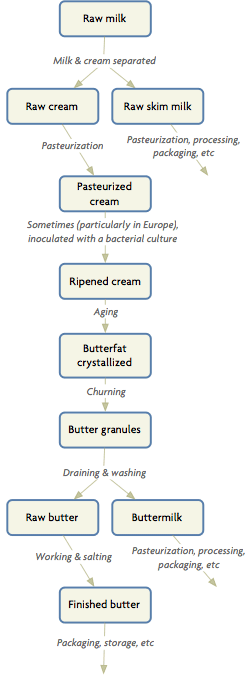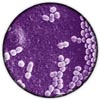Milk & cream
 Collected from cows. Butter can also be produced from the milk of buffalo, camel, goat, ewe, and mares. Cream is separated from the milk. The cream can be either supplied by a fluid milk dairy or separated from whole milk by the butter manufacturer. The cream should be sweet (pH greater than 6.6), not rancid, not oxidized, and free from off flavors. The cream is pasteurized at a temperature of 95°C or more to destroy enzymes and micro-organisms.
Collected from cows. Butter can also be produced from the milk of buffalo, camel, goat, ewe, and mares. Cream is separated from the milk. The cream can be either supplied by a fluid milk dairy or separated from whole milk by the butter manufacturer. The cream should be sweet (pH greater than 6.6), not rancid, not oxidized, and free from off flavors. The cream is pasteurized at a temperature of 95°C or more to destroy enzymes and micro-organisms.
 Ripening
Ripening
Sometimes, cultures are added to ferment milk sugars to lactic acid and desirable flavor and aroma characteristics for cultured butter. This is more common in European butters.
Aging
Cream is held at cool temperatures to crystallize the butterfat globules, ensuring proper churning and texture of the butter. In the aging tank, the cream is subjected to a program of controlled cooling designed to give the fat the required crystalline structure. As a rule, aging takes 12 - 15 hours. From the aging tank, the cream is pumped to the churn or continuous buttermaker via a plate heat exchanger which brings it to the requisite temperature.
Churning
Cream is agitated, and eventually butter granules form, grow larger, and coalesce. In the end, there are two phases left: a semisolid mass of butter, and the liquid left over, which is the buttermilk.
Draining & washing
Thus the cream is split into two fractions: butter grains and buttermilk. In traditional churning, the machine stops when the grains have reached a certain size, whereupon the buttermilk is drained off. With the continuous buttermaker the draining of the buttermilk is also continuous.
After draining, the butter is worked to a continuous fat phase containing a finely dispersed water phase. It used to be common practice to wash the butter after churning to remove any residual buttermilk and milk solids but this is rarely done today. This washing process would ensure that all the butter milk is washed out of the butter. Otherwise the butter would not keep and go rancid.
Salting & working
Salt is used to improve the flavor and the shelf-life, as it acts as a preservative. Further, the butter is worked to improve its consistency.
Packing & storage
The butter is finally patted into shape and then wrapped in waxed paper and then stored in a cool place. As it cools, the butterfat crystallizes and the butter becomes firm. Whipped butter , made by whipping air or nitrogen gas into soft butter , is intended to spread more easily at refrigeration temperatures.
